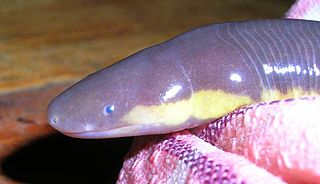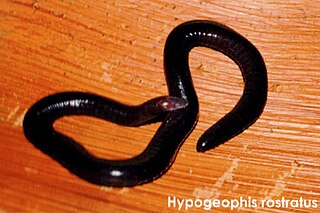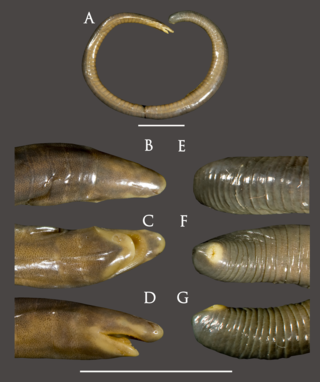
Caecilians are a group of limbless, vermiform (worm-shaped) or serpentine (snake-shaped) amphibians with small or sometimes nonexistent eyes. They mostly live hidden in soil or in streambeds, and this cryptic lifestyle renders caecilians among the least familiar amphibians. Modern caecilians live in the tropics of South and Central America, Africa, and southern Asia. Caecilians feed on small subterranean creatures such as earthworms. The body is cylindrical and often darkly coloured, and the skull is bullet-shaped and strongly built. Caecilian heads have several unique adaptations, including fused cranial and jaw bones, a two-part system of jaw muscles, and a chemosensory tentacle in front of the eye. The skin is slimy and bears ringlike markings or grooves and may contain scales.

The Ichthyophiidae are the family of Asiatic tailed caecilians or fish caecilians found in South and Southeast Asia as well as southernmost China.

Ichthyophis is a genus of caecilians found in Southeast Asia, the southern Philippines, and the western Indo-Australian Archipelago.

The Cylindrophiidae are a monotypic family of secretive, semifossorial, non-venomous snakes containing the genus Cylindrophis found in southeastern Asia. These are burrowing snakes and most have a banded pattern on the belly. Currently, 13 species are recognized, all with no subspecies. Common names include Asian pipe snakes or Asian cylinder snakes.

Microhyla, commonly known as the rice frogs or narrow-mouthed frogs, is a genus of frogs in the family Microhylidae. It consists of 42 species of diminutive frogs. Members of this genus are widespread from Ryukyu Is. in Japan, and throughout South-east Asia,.

The Bombay caecilian is an amphibian found in India. This rather large species is found in the northern Western Ghats. The eyes are distinct and surrounded by a light ring. The tentacle is placed closer to the lip than the eye. A dark brown or greyish-brown species, it has no lateral stripes.

Ichthyophis garoensis, the Garo Hills caecilian, is a species of caecilian found in Assam and Meghalaya in north-eastern India. The Husain's caecilian Ichthyophis husaini was until 2016 considered a separate species. It is a subterranean caecilian that lives in the moist leaf-litter of tropical forests. It is typically found close to streams and other waterbodies.
Chikila fulleri, also known as the Kuttal caecilian, Fuller's caecilian, and Fuller's chikila, is a species of caecilian from South Asia. In 2012 it was reassigned to a newly erected family, Chikilidae.
Indotyphlus maharashtraensis is a species of caecilians described in 2004 by scientists of Bombay Natural History Society and the Natural History Museum, London. It is only the second species of Indotyphlus known to science, and only known from its type locality near Humbarli village, Satara District, in the Western Ghats of Maharashtra, India. Common names Humbarli caecilian, Maharashtra caecilian, and Konkan tail-less caecilian have been coined for it.

The Western Ghats in India are home to several species of caecilians (Gymnophiona). Caecilians are legless, burrowing amphibians which mostly live in leaf litter, loose soil, under rocks and decaying logs. They are also found in agricultural fields and only surface during the monsoon. The body is elongated and smooth with a slimy skin. The smaller caecilians superficially resemble earthworms while the larger ones are often mistaken for snakes. However, they can be told apart from earthworms by the presence of eyes, teeth and skeleton and from snakes by the lack of scales on skin. The eyes in caecilians are not well developed which is most likely to be because of their burrowing life style. They are considered as rare which is apparently due to their subterranean habits. To see them one has to search carefully and be at the right place and at the right time. There are few places where they are common, but, at least one species was reported to be abundant in agricultural fields in Kerala. The larger caecilians can resemble snakes, but their skin is smooth, not scaly.

Microcaecilia is a genus of caecilians in the family Siphonopidae.

The Koh Tao Island caecilian is a species of amphibian in the family Ichthyophiidae found in Cambodia, Laos, Myanmar, Thailand, and Vietnam. Also known as the Ichthyophis bannanicus, the Banna caecilian, it is also found in southern China.
Gegeneophis is a genus of amphibians in the family Grandisoniidae. They are found in southern and northeastern India.

The Grandisoniidae are a family of common caecilians found in Africa, Seychelles and India. Like other caecilians, they superficially resemble worms or snakes. The family was formerly known as Indotyphlidae.
Ichthyophis moustakius, the Manipur moustached caecilian, is a species of caecilian in the family Ichthyophiidae. It is endemic to Northeast India. This species exhibits broad lateral yellow stripes from the anterior part of its tail, along its mandibles, between its nares, as well as elsewhere. The animal can reach a length of 300 millimetres (12 in). Its head is somewhat U-shaped and fairly short; scales are absent on its collars. The species' name is derived from the Greek word moustakius, meaning "moustache", due to the yellow arched stripes it possesses.

Chikila is a genus of amphibian in the order Gymnophiona (caecilians). It is the only genus within the family Chikilidae. All members of the genus are known from northeast India and Bangladesh.
Ichthyophis khumhzi, the Khumhzi striped ichthyophis, is a species of caecilian found in India. It has narrow and irregular lateral yellow stripes. It can attain lengths larger than 400 mm (16 in). Its head is V-shaped while short; the animal shows scales as far anterior as its collars. The species is named after Khumhzi village, where the specimens were first collected.
Ichthyophis sendenyu, the Sendenyu striped ichthyophis, is a species of caecilian found in India. This species of Ichthyophis possesses broad and solid lateral yellow stripes from about the level of the posterior of its disc to its eye level on the upper jaw, while arched yellow stripes extend to its nares. Its length does not exceed 350 millimetres (14 in). Its head is U-shaped and short. Scales are present in anteriormost grooves, with five to eight rows placed posteriorly on its dorsum. It is named after Sendenyu village, Nagaland, where the species was first found.

Ichthyophis kodaguensis, also known as the Kodagu striped Ichthyophis, is a species of caecilian in the family Ichthyophiidae. It is endemic to the southern Western Ghats, India. All confirmed records are from southern Karnataka state, although it is also reported from adjacent Kerala.












